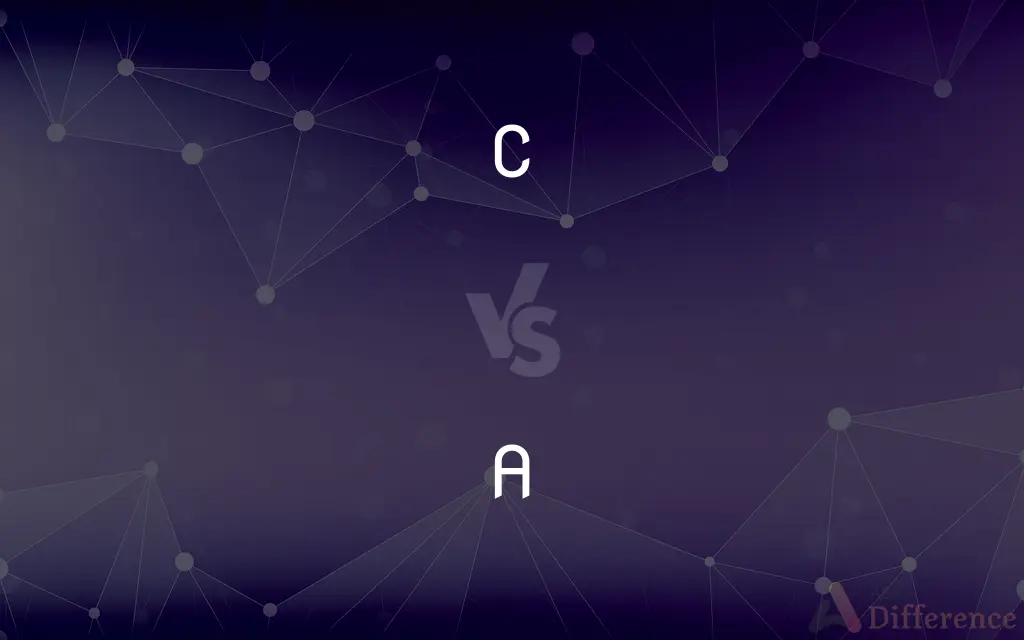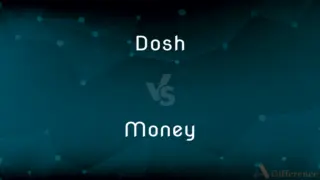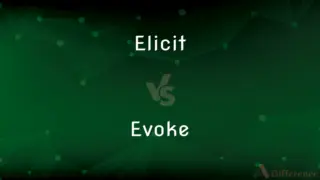C vs. A — What's the Difference?
By Tayyaba Rehman & Maham Liaqat — Updated on April 5, 2024
C is a general-purpose, procedural programming language supporting structured programming, whereas A is not a programming language but might be mistakenly referred to in discussions; it's crucial to specify context.

Difference Between C and A
Table of Contents
ADVERTISEMENT
Key Differences
C is a foundational programming language developed in the early 1970s, known for its efficiency and control over system resources, making it ideal for system/software development. Whereas A, lacking a clear definition, isn't recognized as a programming language, leading to confusion unless it's contextualized, perhaps as a placeholder or a variable in programming discussions.
C's syntax and semantics set a standard for many other programming languages, emphasizing minimalism and flexibility. On the other hand, "A" could refer to anything outside a programming context or be a mere placeholder within one, making direct comparison challenging without additional context.
The language C has a vast standard library that provides routines for a wide range of activities like input/output processing, string manipulation, and memory management. Whereas, since "A" is undefined, it lacks such a library, highlighting the practical applications and utility C brings to programming.
C programs are compiled, translating source code into machine language that runs directly on hardware, offering speed and efficiency. In contrast, without a specific context, "A" lacks a defined compilation or execution model, emphasizing C's role in developing performance-critical applications.
C's influence is evident in the development of subsequent languages like C++, Java, and C#, demonstrating its foundational role. Whereas "A," undefined as a programming language, cannot claim such influence, underlining the significance of C in the programming landscape.
ADVERTISEMENT
Comparison Chart
Type
Programming language
Undefined without context
Purpose
System/software development, general-purpose programming
Context-dependent
Standard Library
Extensive (e.g., input/output, string manipulation)
None
Execution
Compiled to machine language
Undefined
Influence
Influential in the development of many modern programming languages
No influence as it's not a language
Compare with Definitions
C
General-purpose programming language:
C is used for developing operating systems like UNIX.
A
Mathematical variable.
In the equation a + b = c, a is a variable.
C
Procedural programming support:
C allows structured programming where the program is divided into functions.
A
Article.
A book on the table signifies it's not specific.
C
Syntax foundation:
C's syntax influenced the design of many other programming languages.
A
Grade symbol.
An A grade represents outstanding academic performance.
C
Low-level access to memory:
C provides pointers for direct memory access.
A
Musical note.
A is a note in the musical scale.
C
Compiled language:
C code is compiled into machine language, making it extremely fast.
A
First letter of the English alphabet.
A is often used to start lists.
C
The first note of the diatonic scale of C major, the major scale having no sharps or flats.
A
In, to, or for each; per (used when expressing rates or ratios)
Typing 60 words a minute
A move to raise petrol prices by 3p a litre
C
The Roman numeral for 100.
A
A, or a, is the first letter and the first vowel letter of the modern English alphabet and the ISO basic Latin alphabet. Its name in English is a (pronounced ), plural aes.
C
C, or c, is the third letter in the English and ISO basic Latin alphabets. Its name in English is cee (pronounced ), plural cees.
A
Used when mentioning someone or something for the first time in a text or conversation
It has been an honour to meet you
A man came out of the room
C
The third letter of the alphabet.
A
Used to indicate membership of a class of people or things
He is a lawyer
This car is a BMW
C
A shape like that of a letter C
C-springs
A
The first letter of the alphabet.
C
A computer programming language originally developed for implementing the Unix operating system.
A
A shape like that of a capital A
An A-shape
C
A widely used programming language.
A
The sixth note of the diatonic scale of C major. The A above middle C is usually used as the basis for tuning and in modern music has a standard frequency of 440 Hz.
C
The third letter of the modern English alphabet.
A
The first letter of the modern English alphabet.
C
Any of the speech sounds represented by the letter c.
A
Any of the speech sounds represented by the letter a.
C
The third in a series.
A
The first in a series.
C
Something shaped like the letter C.
A
Something shaped like the letter A.
C
C The third best or third highest in quality or rank
A mark of C on a term paper.
A
A The best or highest in quality or rank
Grade A milk.
C
The first tone in the scale of C major or the third tone in the relative minor scale.
A
The sixth tone in the scale of C major or the first tone in the relative minor scale.
C
A key or scale in which the tone of C is the tonic.
A
A key or scale in which A is the tonic.
C
A written or printed note representing this tone.
A
A written or printed note representing this tone.
C
A string, key, or pipe tuned to the pitch of this tone.
A
A string, key, or pipe tuned to the pitch of this tone.
C
A widely used object-oriented programming language based on C.
A
In every; to each; per
Once a month.
One dollar a pound.
C
Alternative form of c.
A
To do with separation; In, into.
Torn a pieces.
C
Alternative form of c.
A
To do with time; Each, per, in, on, by.
I brush my teeth twice a day.
C
C is the third letter of the English alphabet. It is from the Latin letter C, which in old Latin represented the sounds of k, and g (in go); its original value being the latter. In Anglo-Saxon words, or Old English before the Norman Conquest, it always has the sound of k. The Latin C was the same letter as the Greek
A
To do with status; In.
C
The keynote of the normal or "natural" scale, which has neither flats nor sharps in its signature; also, the third note of the relative minor scale of the same.
A
(archaic) To do with position or direction; In, on, at, by, towards, onto.
Stand a tiptoe.
C
As a numeral, C stands for Latin centum or 100, CC for 200, etc.
A
(archaic) To do with process, with a passive verb; In the course of, experiencing.
C
A degree on the Centigrade scale of temperature
A
(archaic) To do with an action, an active verb; Engaged in.
C
The speed at which light travels in a vacuum; the constancy and universality of the speed of light is recognized by defining it to be exactly 299,792,458 meters per second
A
(archaic) To do with an action/movement; To, into.
C
One of the four nucleotides used in building DNA; all four nucleotides have a common phosphate group and a sugar (ribose)
A
(obsolete) To do with method; In, with.
C
A base found in DNA and RNA and derived from pyrimidine; pairs with guanine
A
(obsolete) To do with role or capacity; In.
A God’s name.
C
An abundant nonmetallic tetravalent element occurring in three allotropic forms: amorphous carbon and graphite and diamond; occurs in all organic compounds
A
Of.
The name of John a Gaunt.
C
Ten 10s
A
Have.
I'd a come, if you'd a asked.
C
A unit of electrical charge equal to the amount of charge transferred by a current of 1 ampere in 1 second
A
He, or sometimes she, it. en
C
A general-purpose programing language closely associated with the UNIX operating system
A
All.
C
The 3rd letter of the Roman alphabet
A
All.
C
Street names for cocaine
A
The first letter of the English and of many other alphabets. The capital A of the alphabets of Middle and Western Europe, as also the small letter (a), besides the forms in Italic, black letter, etc., are all descended from the old Latin A, which was borrowed from the Greek Alpha, of the same form; and this was made from the first letter ( ) of the Phœnician alphabet, the equivalent of the Hebrew Aleph, and itself from the Egyptian origin. The Aleph was a consonant letter, with a guttural breath sound that was not an element of Greek articulation; and the Greeks took it to represent their vowel Alpha with the ä sound, the Phœnician alphabet having no vowel symbols.
C
Being ten more than ninety
A
The name of the sixth tone in the model major scale (that in C), or the first tone of the minor scale, which is named after it the scale in A minor. The second string of the violin is tuned to the A in the treble staff. - A sharp (A$) is the name of a musical tone intermediate between A and B. - A flat (A$) is the name of a tone intermediate between A and G.
O fair Creseide, the flower and A per seOf Troy and Greece.
A
An adjective, commonly called the indefinite article, and signifying one or any, but less emphatically.
A
In each; to or for each; as, "twenty leagues a day", "a hundred pounds a year", "a dollar a yard", etc.
A
Of.
A
A barbarous corruption of have, of he, and sometimes of it and of they.
A
An expletive, void of sense, to fill up the meter
A merry heart goes all the day,Your sad tires in a mile-a.
A
In; on; at; by.
A
In process of; in the act of; into; to; - used with verbal substantives in -ing which begin with a consonant. This is a shortened form of the preposition an (which was used before the vowel sound); as in a hunting, a building, a begging.
A
A metric unit of length equal to one ten billionth of a meter (or 0.0001 micron); used to specify wavelengths of electromagnetic radiation
A
Any of several fat-soluble vitamins essential for normal vision; prevents night blindness or inflammation or dryness of the eyes
A
One of the four nucleotides used in building DNA; all four nucleotides have a common phosphate group and a sugar (ribose)
A
(biochemistry) purine base found in DNA and RNA; pairs with thymine in DNA and with uracil in RNA
A
The basic unit of electric current adopted under the Systeme International d'Unites;
A typical household circuit carries 15 to 50 amps
A
The 1st letter of the Roman alphabet
Common Curiosities
What is C used for?
C is widely used for system and application development, offering close-to-hardware operations.
Is A a programming language?
Without additional context, A does not refer to a recognized programming language.
Can C be used for web development?
While not common, C can be used in web development, particularly for backend services requiring high performance.
Is C suitable for beginners?
C's low-level features make it challenging for beginners, though it offers a strong foundation in programming concepts.
Can A represent a value or concept in programming?
Yes, as a variable, "A" can represent values or concepts within programs.
How is A typically used in educational contexts?
As a grade, it represents excellence; it may also be used to introduce alphabetical or numerical concepts.
How does C manage memory?
C provides manual memory management through pointers and memory allocation functions.
How does C handle object-oriented programming?
C does not support object-oriented programming directly; it's a procedural language.
What makes C fast?
Its compilation into machine language and low-level capabilities make C extremely fast.
Do I need to know C to learn C++ or Java?
While not necessary, understanding C can provide a solid foundation for C++ or Java.
What's the significance of 'A' in programming contexts?
"A" can serve as a variable or placeholder, but its significance depends on specific usage.
Does A have any specific meaning in mathematics?
It often serves as a variable or constant in equations and formulas.
What are some languages influenced by C?
C++ and Java are among the languages significantly influenced by C.
Can C be used on modern operating systems?
Yes, C is compatible with virtually all modern operating systems.
Is there any programming language starting with 'A'?
Yes, languages like Assembly, Ada, and ActionScript start with 'A'.
Share Your Discovery

Previous Comparison
Dosh vs. Money
Next Comparison
Elicit vs. EvokeAuthor Spotlight
Written by
Tayyaba RehmanTayyaba Rehman is a distinguished writer, currently serving as a primary contributor to askdifference.com. As a researcher in semantics and etymology, Tayyaba's passion for the complexity of languages and their distinctions has found a perfect home on the platform. Tayyaba delves into the intricacies of language, distinguishing between commonly confused words and phrases, thereby providing clarity for readers worldwide.
Co-written by
Maham Liaqat












































